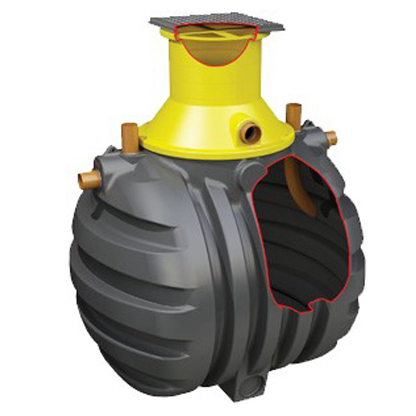
A sewage treatment system is a chambered tank which keeps sewage for enough time to allow bacteria to turn the solids into sludge and liquid effluent.
A sewage treatment system collects the sewage allowing bacteria and enzymes to breakdown the contamination.
Sewage and waste water from the building flows into the septic tank via the inlet pipe. The sewage treatment system is a living, working ecosystem in which friendly bacteria digest the waste creating safe effluent (waste liquid). The effluent drains from the tank via the outlet pipe to the soak away where it gets further treatment from micro-organisms in the surrounding soil. For further information on how a sewage treatment system works please see our Sewage Treatment System Maintenance Advice Sheet.
Yes. A sewage treatment system will need to be desludged (emptied) on a regular basis as it’s unlikely that the sludge at the bottom of the tank will disappear. The more sludge there is at the bottom of the tank the less space there is for the waste to be digested and untreated waste may flow out into the soak away, clogging it and polluting the environment.
Your sewage treatment system should be desludged in accordance with the manufacturers’ instructions.
There are a few things that need to be considered and approved before you install a new sewage treatment system. Firstly you have to ensure that the sewage treatment system and soak away is the correct size and suitable for the sewage it will be handling. For further information on this please contact Filpumps or your local authority building standards department.
Your local authority building standards department will also have to approve the proposed system and will issue a building standards reference number. You will then have to register the sewage discharge with SEPA in Scotland or EA in England and Wales. For more information on registering the sewage discharge please contact SEPA or EA.
Your local authority building standards department may still have to pass approval if you are replacing a sewage system – please contact them for more information.
Only the three Ps should be flushed down the toilet – Pee, Poo and Paper (toilet). Any other waste such as wipes, nappies, sanitary products, condoms and cotton buds should be bagged and binned as they can cause physical blockages that the septic system cannot cope with and no amount of bacteria can clear.
Food scraps, fats and oils should also be bagged and binned as they can also cause the physical blockages that the system cannot cope with.
Paints, solvents, caustics and chemicals should not be put down the drains as not only can some of them cause physical blockages but they can kill the bacterium which makes the sewage treatment system work. If this bacterium is not present in the septic tank the septic waste will not be broken down and raw sewage will seep into the soak away causing environmental pollution.
Care should also be taken when using household cleaners, bleach and detergents. These should be suitable for septic tanks if possible (such as non-bio washing powder instead of bio which can kill the bacteria in the tank) and used sparingly, especially harsh cleaners like toilet bleach. Cleaning tasks which require a lot of water such as using the washing machine or dishwasher should be spaced out so the septic system is not over loaded with water at one time.
For more information on maintaining your sewage treatment system, please see our Sewage Treatment System Maintenance Advice Sheet,
Firstly your sewage treatment system needs to be registered with your local Environment Agency (SEPA in Scotland). Registration means you have authorisation to use the tank.
As an owner or user of a sewage treatment system it is your responsibility to ensure that the discharge into the soak away is not damaging the environment. You also have to make sure that it is secure and in good working order and the drains to and from the sewage treatment system are free of blockages.
If your sewage treatment system leaks, floods or causes foul odours because of poor maintenance (such as blockages, overflows or damage) you may have a statutory notice issued which will force you to maintain, repair or replace your sewage treatment system.
You must act immediately if you find a blockage or any other signs of a problem.